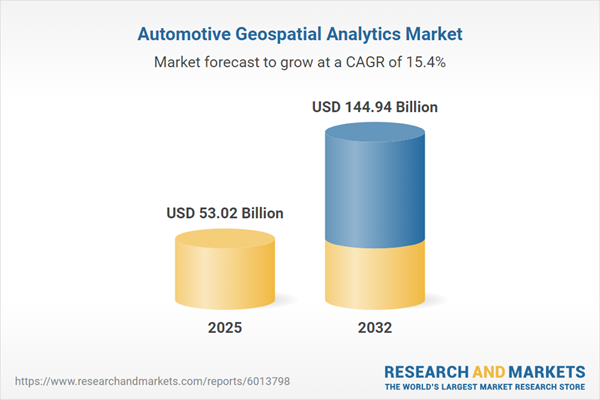Speak directly to the analyst to clarify any post sales queries you may have.
The Automotive Geospatial Analytics Market is equipping senior decision-makers in the mobility sector with advanced tools to drive informed, data-backed decisions. By integrating geospatial intelligence, mobility organizations are able to adapt processes quickly, ensuring enhanced efficiency and competitive advantage.
Market Snapshot: Automotive Geospatial Analytics Market
The Automotive Geospatial Analytics Market is advancing at a robust pace, propelled by widespread adoption of connected vehicle and automation technologies. In 2024, the market is valued at USD 45.98 billion, with projections indicating expansion to USD 53.02 billion in 2025 and USD 144.94 billion by 2032. This growth reflects a compound annual growth rate (CAGR) of 15.43%. The momentum stems from deepening reliance on digital platforms, progressive business models centered on services and automation, as well as the deployment of sophisticated analytics capabilities. Companies leveraging automotive geospatial analytics benefit from improved productivity in fleet operations, enhanced rider safety, and the ability to unlock innovative, data-driven mobility solutions within the evolving global transportation landscape.
Scope & Segmentation
This analysis delivers a comprehensive overview of the segments reshaping the Automotive Geospatial Analytics Market, supporting executives to target investments and spur innovation aligned with changing mobility demands:
- Offering: Encompasses hardware, software, and services vital for seamless geospatial analytics deployment and their integration with current transport technologies.
- Application: Spans areas such as autonomous driving, scalable mobility offerings, insurance telematics, advanced fleet management, and multi-dimensional mapping across commercial, passenger, and logistics sectors.
- Deployment: Includes adaptable options like cloud, hybrid, and on-premises models to allow tailored data workflow solutions per organizational objectives.
- Sensor Type: Relies on camera, LiDAR, radar, and ultrasonic sensors, each contributing to accurate analytics that support safety and reliable geospatial intelligence in diverse operational settings.
- Vehicle Type: Solutions target passenger and commercial fleets, supporting logistics effectiveness, robust asset tracking, and meeting specific requirements for evolving mobility applications.
- Level of Autonomy: Addresses all automation stages, from advanced driver-support systems to fully autonomous operations, underpinning sustained market relevance as automation intensifies.
- Region: Focuses on the Americas, Europe, Middle East & Africa, and Asia-Pacific, examining shifts in regulatory context and variations in digital infrastructure maturation that influence adoption rates and operational strategies.
- Leading Companies: Features organizations such as Google LLC, HERE Global B.V., TomTom N.V., Hexagon AB, Trimble Inc., Mapbox, Autodesk, and Caliper Corporation, all instrumental in digital mapping and analytics ecosystems development.
Key Takeaways for Senior Decision-Makers
- Integrating geospatial analytics empowers organizations to react swiftly to dynamic mobility requirements, ensuring ongoing market relevance and strengthening operational capabilities.
- Advanced sensor integration and analytics tools offer enhanced transparency into fleet conditions, enabling efficient routing, asset utilization, and strategic maintenance planning.
- Collaborative partnerships among manufacturers, technology providers, and analytics specialists foster the development of interoperable digital transport ecosystems, elevating technology value for all stakeholders.
- Adopting proactive regulatory compliance strategies enables organizations to minimize potential risks and facilitate access to wider markets, supporting long-term international operations stability.
- Strategic management of supply chains contributes to organizational resilience, facilitating adaptation to procurement shifts and helping maintain stability amid changing industry standards.
Tariff Impact on the Automotive Geospatial Analytics Market
With projected US tariff adjustments slated for 2025, the sector is undergoing significant supply chain reconfiguration, particularly regarding procurement of sensors and critical hardware components. This evolving landscape is encouraging localized manufacturing investment and driving efforts to streamline procurement practices. By moving toward local sourcing and agile logistics, organizations are positioned to reduce trade risk exposure, minimize overseas dependencies, and better navigate ongoing market volatility.
Methodology & Data Sources
This report’s findings and recommendations are grounded in direct engagement with senior industry leaders and technical experts. Insights have been corroborated through systematic benchmarking and transparent evaluation of the latest market studies, assuring executive-level relevance and reliability.
Why This Report Matters
- Offers clear analysis of regulatory shifts and their implications on mobility strategies, enabling leadership to respond to industry transformation with agility.
- Delivers actionable guidance to support digitalization initiatives and enhance preparedness for evolving global mobility trends.
- Provides senior leadership with tools to anticipate risks and manage intricate international market challenges strategically.
Conclusion
Automotive geospatial analytics are central to effective industry adaptation, delivering tools that support strategic agility. With this insight, organizations are equipped to strengthen resilience and harness future mobility opportunities.
Additional Product Information:
- Purchase of this report includes 1 year online access with quarterly updates.
- This report can be updated on request. Please contact our Customer Experience team using the Ask a Question widget on our website.
Table of Contents
3. Executive Summary
4. Market Overview
7. Cumulative Impact of Artificial Intelligence 2025
Companies Mentioned
The companies profiled in this Automotive Geospatial Analytics market report include:- Google LLC
- HERE Global B.V.
- TomTom N.V.
- Hexagon AB
- Trimble Inc.
- Mapbox, Inc.
- Autodesk, Inc.
- Caliper Corporation
Table Information
| Report Attribute | Details |
|---|---|
| No. of Pages | 183 |
| Published | October 2025 |
| Forecast Period | 2025 - 2032 |
| Estimated Market Value ( USD | $ 53.02 Billion |
| Forecasted Market Value ( USD | $ 144.94 Billion |
| Compound Annual Growth Rate | 15.4% |
| Regions Covered | Global |
| No. of Companies Mentioned | 9 |









